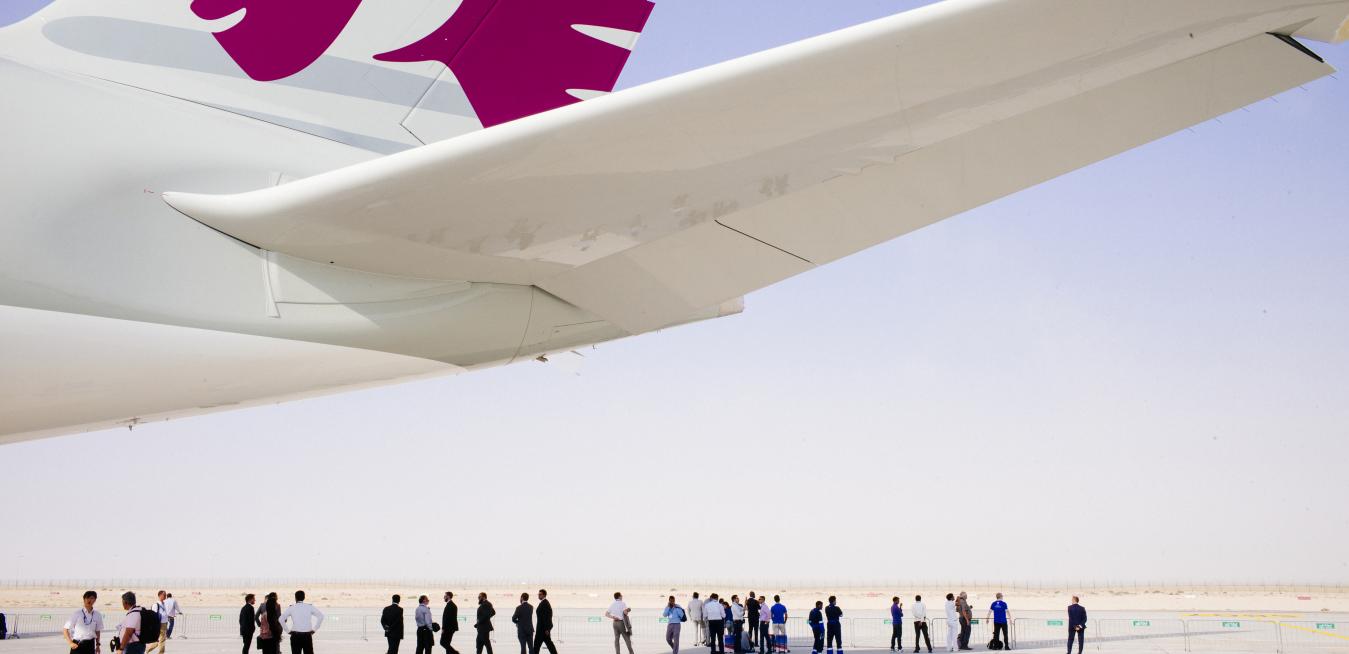Starting on Feb. 1, Emirates launched the world’s longest passenger flight between Dubai and Panama City. A westbound Boeing 777-200LR powered by a pair of GE90 engines covers the 8,950 miles that separates them on a single tank of gas in 17 hours and 35 minutes. But that record may soon topple. In January, Qatar Airways announced plans to launch a 9,034-mile flight lasting 18 hours and 30 minutes between Doha and Auckland in New Zealand. That route would use an Airbus A350 plane, which has GE composite components in its wings. Finally, United launched the longest flight originating at a U.S. airport between San Francisco and Singapore in June. It's the world’s longest scheduled route flown by a GEnx-powered Boeing’s 787 Dreamliner. The eastbound leg lasts 15h 30min and the westbound trip back clocks in at 16h 20min.
We have assembled a playlist at the bottom of the story to help you pass the time.
 Qatar Airways just announced plans to launch a 9,034-mile flight lasting 18 hours and 30 minutes. Above: A Qatar Airways's 25th Boeing 787 powered GEnx engines. Images credit: Adam Senatori for GE Reports
Qatar Airways just announced plans to launch a 9,034-mile flight lasting 18 hours and 30 minutes. Above: A Qatar Airways's 25th Boeing 787 powered GEnx engines. Images credit: Adam Senatori for GE ReportsThese new efficiency benchmarks have their origin in the oil shock. NASA, in particular, began a quest to develop an energy-efficient engine for commercial aircraft known as the E3 (E-cubed) program. GE joined early on and developed a new generation of high-bypass turbofan engines starting with the GE90. It has since added the GEnx for the Dreamliner and 747-8, and the GE9X, which is currently in development.
To reduce weight, GE equipped the engines with light, carbon-fiber composite fan blades. To this day no other engine maker has engines with composite fan blades in service today. (The design for the GE90 was so fetching that one blade is now on display at New York’s Museum of Modern Art.). “This was a huge, expensive and risky project,” says Shridhar Nath, who leads the composites lab at GE Global Research. “We planned to replace titanium with what is essentially plastic. We were starting from scratch and we did not know how carbon fiber blades would respond to rain, hail, snow and sand, and the large forces inside the engine.”
 The GEnx engine has 18 fan blades made from lightweight carbon fiber composites. Image credit: GE Aviation
The GEnx engine has 18 fan blades made from lightweight carbon fiber composites. Image credit: GE AviationBut it paid off. “The engines essentially opened the globe up to incredibly efficient, twin-powered, wide-body planes,” says David Joyce, president and CEO of GE Aviation.
The latest engine in the GE family, the GE9X, will power Boeing’s next-generation 777X long-haul jets. Lightweight carbon composites allowed engineers to design an 11-foot fan that can suck a maelstrom of 8,000 pounds of air per second inside the engine. The air will flow into the combustor, where it meets parts made from ceramic matrix composites (CMCs), another breakthrough material developed by GE scientists.
 An Emirates flight between Dubai and Panama City is the current world-record holder, lasting 17 hours and 35 minutes. Image credit: Adam Senatori for GE Reports
An Emirates flight between Dubai and Panama City is the current world-record holder, lasting 17 hours and 35 minutes. Image credit: Adam Senatori for GE ReportsCarbon fiber composites work with cold air at the front of the engine. But CMCs, which were originally developed for massive gas turbines for power plants, operate in the engine’s hot section, at temperatures where even metals grow soft. The extra heat gained by the ceramics gives the engine more energy to work with and makes it more efficient.
 A jet engine turbine blade made from CMCs. Image credit: Adam Senatori for GE Reports
A jet engine turbine blade made from CMCs. Image credit: Adam Senatori for GE ReportsCMCs also have twice the strength and just a third of the weight of their metal counterparts. This allows designers to make parts from them thinner and much lighter, further reducing the weight of the engine. Says GE researcher Krishnan Luthra, who spent two decades developing the material: “I thought it would be the Holy Grail if we could make it work.”
 Boeing's 737 MAX jet powered by LEAP-1B engines at the Farnborough International Airshow. Image credit: Adam Senatori for GE Reports
Boeing's 737 MAX jet powered by LEAP-1B engines at the Farnborough International Airshow. Image credit: Adam Senatori for GE Reports![F414_CMC LPT blade_ECB coatings[1]](https://www.ge.com/news/sites/default/files/Reports/uploads/2015/10/F414_CMC-LPT-blade_ECB-coatings1-1024x680.jpg) The next-generation ADVENT adaptive cycle jet engine will have a low pressure turbine with blades made from CMCs. GE aviation already tested them in a working turbine. Image credit: GE Aviation
The next-generation ADVENT adaptive cycle jet engine will have a low pressure turbine with blades made from CMCs. GE aviation already tested them in a working turbine. Image credit: GE Aviation




